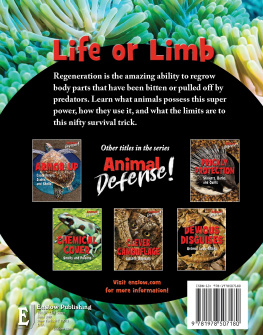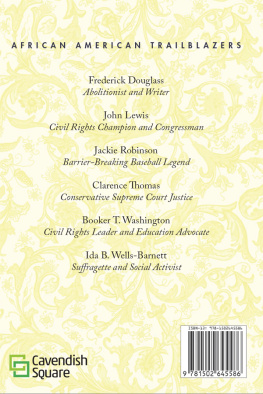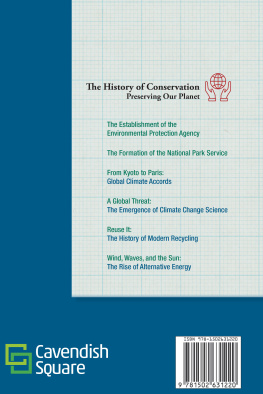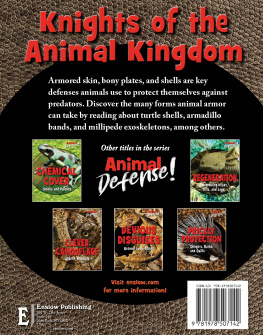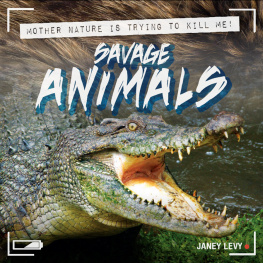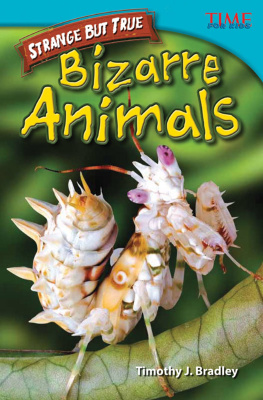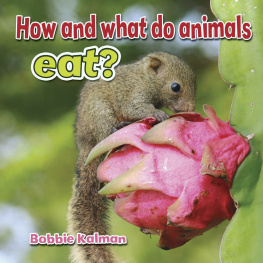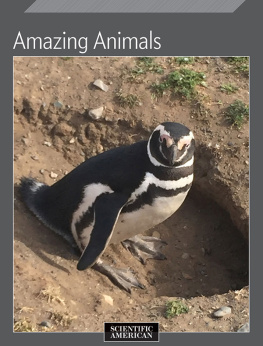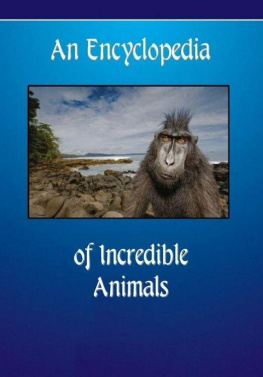
These books are dedicated to Emily, who inspired the author.
Susan K. Mitchell
Published in 2020 by Enslow Publishing, LLC.
101 W. 23rd Street, Suite 240, New York, NY 10011
Copyright 2020 by Enslow Publishing, LLC.
All rights reserved.
No part of this book may be reproduced by any means without the written permission of the publisher.
Library of Congress Cataloging-in-Publication Data
Names: Hurt, Avery Elizabeth, author. | Mitchell, Susan K., author.
Title: Regeneration: regrowing heads, tails, and legs / Avery Elizabeth Hurt and Susan K. Mitchell.
Description: New York: Enslow Publishing, 2020. | Series: Animal defense! | Audience: Grade 3-6. | Includes bibliographical references and index.
Identifiers: LCCN 2018051067| ISBN 9781978507180 (library bound) | ISBN 9781978508170 (paperback)
Subjects: LCSH: Regeneration (Biology)Juvenile literature. | Animal defensesJuvenile literature.
Classification: LCC QP90.2 .H87 2020 | DDC 571.8/89dc23
LC record available at https://lccn.loc.gov/2018051067
Printed in the United States of America
To Our Readers: We have done our best to make sure all website addresses in this book were active and appropriate when we went to press. However, the author and the publisher have no control over and assume no liability for the material available on those websites or on any websites they may link to. Any comments or suggestions can be sent by email to customerservice@enslow.com.
Portions of this book originally appeared in Animal Body-Part Regenerators: Growing New Heads, Tails, and Legs.
Photo Credits: Claus Lunau/Science Source.
Contents
Introduction
F or animals, life in the wild can be dangerous. They have to find a place to live and protect their territory. Then they have to find mates. Sometimes, they have to fight for mates. When they have young, they have to protect themand themselvesfrom predators. This takes skill.
Over many years, animals have in different ways to survive. When it comes to defending themselves from predators, animals have many interesting tricks.
Animals have different defenses depending on the skills their predators have. Rabbits and deer are often preyed on by fast-moving animals, such as big cats. So they have developed the ability to run very fast. This helps them get away from these predators.
Turtles are often preyed upon by animals with sharp teeth. They have developed hard shells to protect their bodies. Porcupines have prickly spines they can poke into predators.
Small animals often cant do much to fight off big animals trying to eat them. But fighting isnt always the best idea. Some small animals have developed ways to defend themselves that dont involve fighting. Some frogs have poisonous skin. Skunks can put out a terrible stink. This drives predators away. Some animals use to help them blend in. Predators wont even see them.
These are all cool defenses. But one animal defense is truly amazing. Some animals can regrow lost body parts. This is called regeneration.
Losing a limb is one of the most serious injuries most people can imagine. When people lose limbs, their lives are changed forever. Its the same way for most animals, too. If a fox loses a leg, it wont be able to get around to look for food. It wont be able to run from predators. If it doesnt die from the injury, it might starve to death or be eaten.
But for some animals, losing a leg or a tail is no big deal. They can easily grow another one. This can be a lifesaver. First, being able to give up the leg or tail means the animal gets away and doesnt become lunch. Second, being able to regrow the missing body part means the animal doesnt have to try to survive without an important piece of equipment.

This lizard is growing a new tail to replace one that it lost, probably while escaping a predator.
Whether these animals live on land, in water, or underground, regeneration is one of the most amazing defenses they use to protect themselves from predators.
Chapter 1
The Special Few
S nap! A predator strikes. It grabs its prey by the tail. The predator is in for a surprise, though. Dinner wrestles free. It runs away leaving only its tail. This is a measly snack for the predator hoping for a full meal. But it works out great for the prey. It gets to live another day. And it may not have to live without its tail. It may be one of the special animals that can grow a new tail! Others can even grow new legs! A few can do a little bit more. They can grow back new eyes or organs. There is even a small group of animals that can grow whole new bodies!
Scientists are not completely sure how the process works. What they do know is that regeneration is possible because of changes in an animals There are many kinds of cells. Cells that are alike gather together to form different parts of the body. Some cells make up skin. Others form bone or muscle. There are special cells in nerves and blood. Each kind of cell has a different job in an animals body. In most animals, most of the time, cells cant change and do a different job. A skin cell is always a skin cell. A blood cell is always a blood cell. If you need more blood cells, skin cells wont be able to help.
A regenerators cells are special. These cells can change jobs. The different cells in the spot where a leg or tail is lost, for example, stop doing their own special jobs. Instead, cells that had different jobs all start doing the same thing. They all help to regrow the missing body part.
Show Some Spine
Almost all animals that can grow new body parts are that completely covers their bodies. Others simply have soft bodies or thick shells that partly cover them.

Mammals have many kinds of cells. These are a few types of cells in human bodies.
Insects, worms, and spiders are all invertebrates. Animals such as clams, starfish, and crabs have no backbone, either. Many animals in this group have very simple bodies. It is easy to forget that they are even animals!
Sponges are a good example of super simple animals. They have no true organs. They are not much more than a group of living cells. Sponges come in many shapes, sizes, and colors. One thing all sponges have in common are their pores. Pores are the holes all over a sponges body.
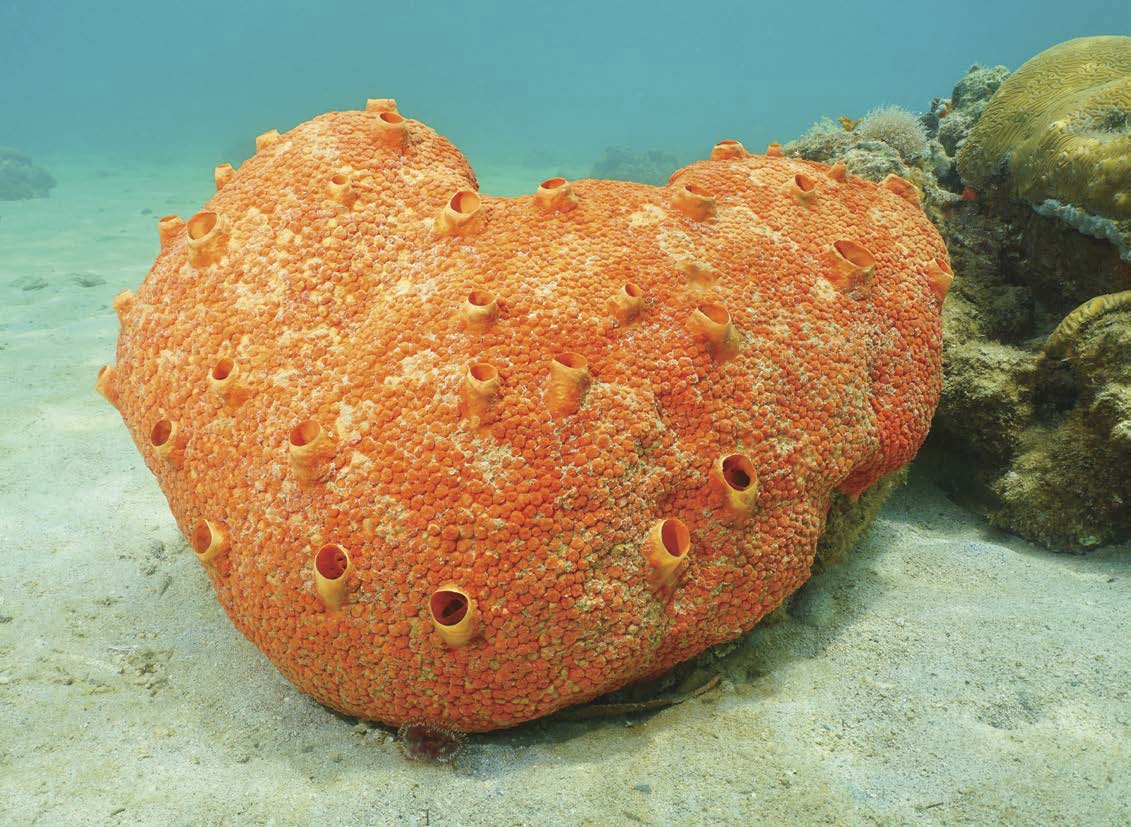
This red sponge is called a boring sponge. Its not uninteresting. Its called a boring sponge because it bores holes in oyster shells.
These holes let water pass through the sponge. Food is filtered from the water. Sponges cannot move, so they simply sit and wait for food. This means that they cannot get away from predators. However, a sponge can regenerate any part of its body that might get eaten. So unless an animal eats the entire sponge, it hasnt done much harm.
What Nerve!
Animals that do have skeletons and backbones are called . All birds and mammals have backbones. Reptiles such as snakes and lizards also belong to this group. So do frogs and their relatives. Although vertebrates have some power of regeneration, very few can grow new body parts.
Animals with backbones usually have complex nervous systems. The nervous system controls the body. It usually includes a brain and spinal cord. It also has a huge network of nerves. This system controls everything the body does, including movement and breathing. It controls muscles. It also allows animals to feel temperature and pain.
Next page
